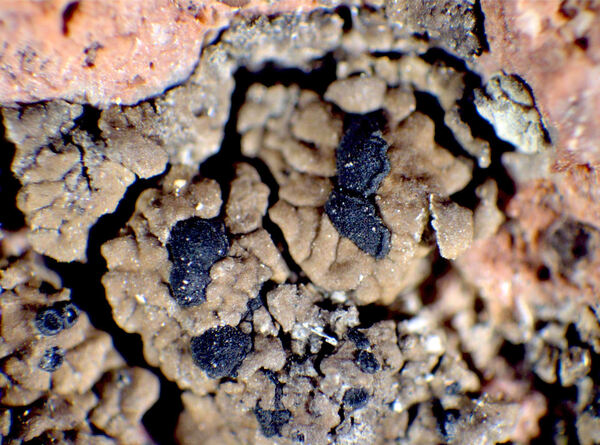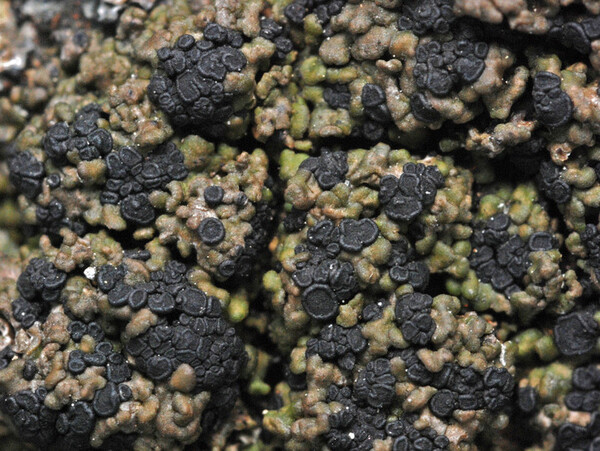Monerolechia badia (Fr.) Kalb
Bibl. Lichenol., 88: 312, 2004. Basionym: Lecidea badia Fr. - Syst. Orb. Veget., 1: 287, 1825.
Synonyms: Buellia badia (Fr.) A. Massal.; Buellia bayrhofferi (Schaer.) H. Olivier; Buellia conioptiza (Nyl.) B. de Lesd.; Buellia duebenii (Fr.) Hellb.; Buellia pernigrans (Nyl.) Sandst.; Buellia schisticola H. Magn.; Catolechia badia (Fr.) Stein; Karschia bayrhofferi (Schaer.) Rehm; Lecidea bayrhofferi Schaer.; Lecidea conioptiza Nyl.; Lecidea pernigrans Nyl.; Monerolechia bayrhofferi (Schaer.) Trevis.; Rhizocarpon badium (Fr.) Sambo
Description: Thallus squamulose to subcrustose, episubstratic, forming up to 1-2 cm wide patches, without a distinct prothallus, the squamules/areoles contiguous, 0.5-1 mm wide, usually convex, matt to shiny, epruinose, chestnut brown to rarely grey-brown, smooth. Cortex of anticlinally arranged, cellular hyphae, the terminal cells swollen, with brown caps, with a thin epinecral layer; medulla white, lacking calcium oxalate crystals, I-. Apothecia lecideine, black, 0.3-1 mm across, with an initially flat, then convex disc and a thin, finally excluded proper margin. Proper exciple narrow, poorly differentiated, Aethalea-type, the outer hyphae parallel, moderately swollen and usually strongly carbonized, the inner part paler; epithecium olive-brown to almost black; hymenium colourless, 50-80 µm high, not inspersed with oil droplets, K/I+ blue; paraphyses easily made free, simple to sparingly branched in upper part, 1.5-2.5 µm thick at mid-level, the apical cells 3-5 µm wide, with a dark brown cap; hypothecium deep reddish brown. Asci 8-spored, with a very thin or even indistinct amyloid layer above the axial body, which is conical with converging flanks (intermediate between the Bacidia and the Lecanora types). Ascospores 1-septate, not constricted at septum, brown, oblong to ellipsoid with obtuse ends, 10-15(-17) x (5-)6-8(-8.5) µm, the septum narrow, not thickening during spore ontogeny, the internal walls of uniform thickness, smooth but the outer wall weakly ornamented in old spores. Pycnidia rare, urceolate to globose, unilocular, the walls with short, conidiophores, the conidiogenous cells terminal. Conidia simple, hyaline, short-bacilliform, 4-5 x 1-1.5 µm. Photobiont chlorococcoid. Spot tests: K-, C-, KC-, P-, UV-. Chemistry: without lichen substances.
Growth form: Crustose
Substrata: rocks
Photobiont: green algae other than Trentepohlia
Reproductive strategy: mainly sexual
paras crustose and foliose lichens
Commonnes-rarity: (info)
Alpine belt: absent
Subalpine belt: rare
Montane belt: very rare
Dry submediterranean belt: extremely rare
Humid submediterranean belt: very rare
Padanian area: absent
pH of the substrata:
1 2 3 4 5
Solar irradiation:
1 2 3 4 5
Aridity:
1 2 3 4 5
Eutrophication:
1 2 3 4 5
Poleotolerance:
0 1 2 3
Altitudinal distribution:
1 2 3 4 5 6
Rarity
absent
extremely rare
very rare
rare
rather rare
rather common
common
very common
extremely common
Loading data...
Occurrence data
Predictive map
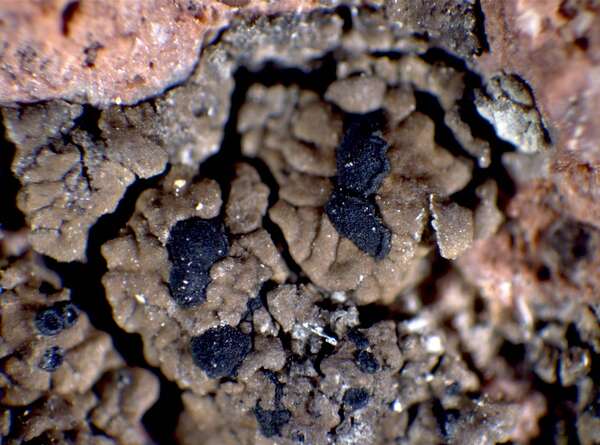
P.L. Nimis; Owner: Department of Life Sciences, University of Trieste
Herbarium: TSB (10161)
2001/11/01
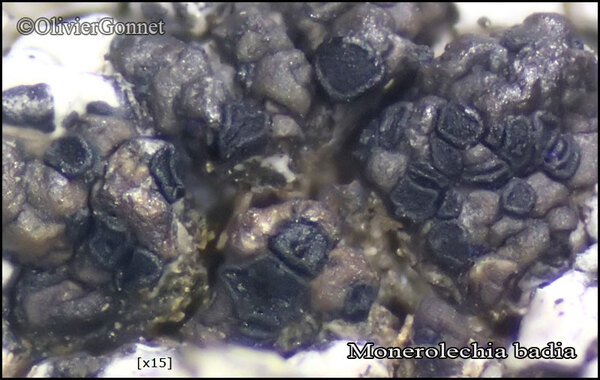
Courtesy Danièle et Olivier Gonnet - Source: https://www.afl-lichenologie.fr/Photos_AFL/Photos_AFL_M/Texte_M/Monerolechia_badia.htm
France, Névache - Hautes-Alpes
3/6/2017
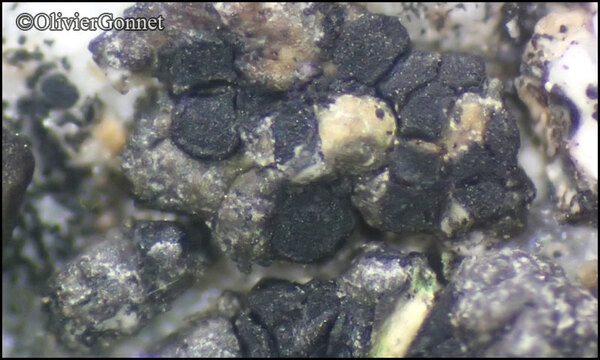
Courtesy Danièle et Olivier Gonnet - Source: https://www.afl-lichenologie.fr/Photos_AFL/Photos_AFL_M/Texte_M/Monerolechia_badia.htm
France, Névache - Hautes-Alpes
3/6/2017
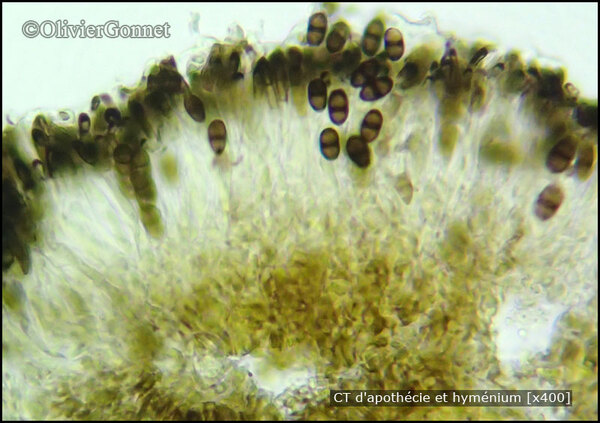
Courtesy Danièle et Olivier Gonnet - Source: https://www.afl-lichenologie.fr/Photos_AFL/Photos_AFL_M/Texte_M/Monerolechia_badia.htm
France, Névache - Hautes-Alpes
3/6/2017
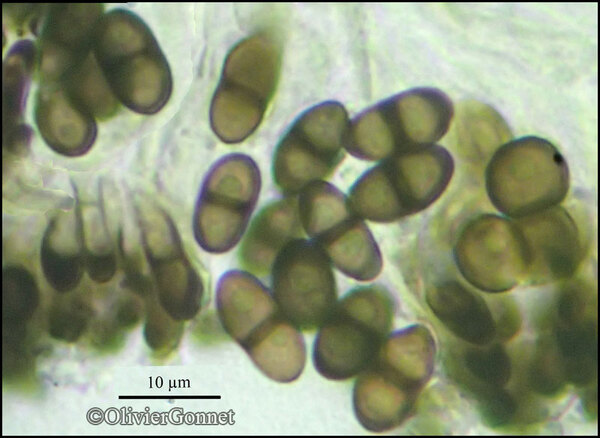
Courtesy Danièle et Olivier Gonnet - Source: https://www.afl-lichenologie.fr/Photos_AFL/Photos_AFL_M/Texte_M/Monerolechia_badia.htm
France, Névache - Hautes-Alpes
3/6/2017
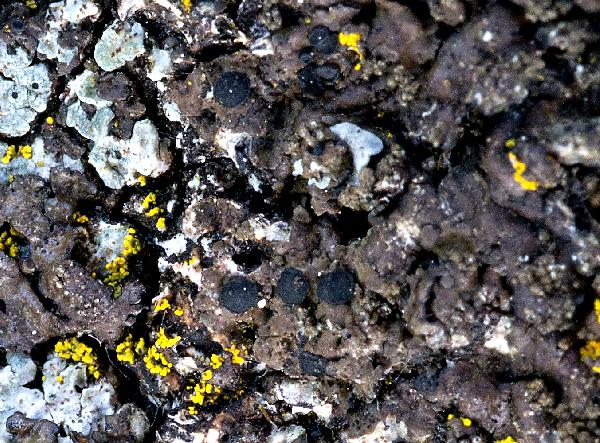
Ulrich Kirschbaum CC BY-SA 4.0 - Source: https://www.thm.de/lse/ulrich-kirschbaum/flechtenbilder
Central Europe; Germany: Hesse. (Ident: Eichler & Cezanne). On basaltic rocks (parasitizing on Xanthoparmelia spec.).
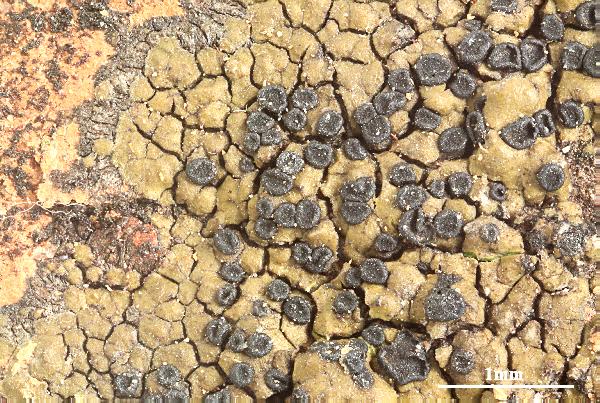
Felix Schumm - CC BY-SA 4.0
[ABL78288], Brazil, Mato Grosso do Sul, Pantanal 83 km SE of
Corumbá, around Base de UFMS, in pantanal forest on roof tile. 19°34’
S, 57°01’05'' W, 90 m. Leg. A. Aptroot (no 78288), 03.03.2019, det. A.
Aptroot, 2019. - Spores 8/ascus, brown, 1-septate, 10-15 x 6-8 μm
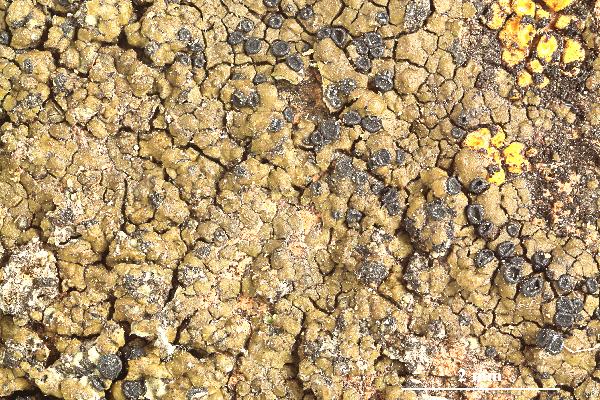
Felix Schumm - CC BY-SA 4.0
[ABL78288], Brazil, Mato Grosso do Sul, Pantanal 83 km SE of
Corumbá, around Base de UFMS, in pantanal forest on roof tile. 19°34’
S, 57°01’05'' W, 90 m. Leg. A. Aptroot (no 78288), 03.03.2019, det. A.
Aptroot, 2019. - Spores 8/ascus, brown, 1-septate, 10-15 x 6-8 μm

Sebastiano Dose - CC BY 4.0
Armenia, Ararat Province, Khosrov Forest State Reserve, municipality of Garni, starting from the NW entrance to the park (ca. 3 km SE from Garni), on rocks and trees along the main gravel road descending the gorge. a) on granitic/acidic and sandstone rocks; b) on shrubs and a poplar tree, ca. 1350 m. 24.09.2024. leg. Dose, Nimis & Muggia TSB 45026
Growth form: Crustose
Substrata: rocks
Photobiont: green algae other than Trentepohlia
Reproductive strategy: mainly sexual
paras crustose and foliose lichens
Commonnes-rarity: (info)
Alpine belt: absent
Subalpine belt: rare
Montane belt: very rare
Dry submediterranean belt: extremely rare
Humid submediterranean belt: very rare
Padanian area: absent
pH of the substrata:
| 1 | 2 | 3 | 4 | 5 |
Solar irradiation:
| 1 | 2 | 3 | 4 | 5 |
Aridity:
| 1 | 2 | 3 | 4 | 5 |
Eutrophication:
| 1 | 2 | 3 | 4 | 5 |
Poleotolerance:
| 0 | 1 | 2 | 3 |
Altitudinal distribution:
| 1 | 2 | 3 | 4 | 5 | 6 |
Rarity
absent
extremely rare
very rare
rare
rather rare
rather common
common
very common
extremely common
Loading data...
Occurrence data
Predictive map

P.L. Nimis; Owner: Department of Life Sciences, University of Trieste
Herbarium: TSB (10161)
2001/11/01

Courtesy Danièle et Olivier Gonnet - Source: https://www.afl-lichenologie.fr/Photos_AFL/Photos_AFL_M/Texte_M/Monerolechia_badia.htm
France, Névache - Hautes-Alpes
3/6/2017

Courtesy Danièle et Olivier Gonnet - Source: https://www.afl-lichenologie.fr/Photos_AFL/Photos_AFL_M/Texte_M/Monerolechia_badia.htm
France, Névache - Hautes-Alpes
3/6/2017

Courtesy Danièle et Olivier Gonnet - Source: https://www.afl-lichenologie.fr/Photos_AFL/Photos_AFL_M/Texte_M/Monerolechia_badia.htm
France, Névache - Hautes-Alpes
3/6/2017

Courtesy Danièle et Olivier Gonnet - Source: https://www.afl-lichenologie.fr/Photos_AFL/Photos_AFL_M/Texte_M/Monerolechia_badia.htm
France, Névache - Hautes-Alpes
3/6/2017

Ulrich Kirschbaum CC BY-SA 4.0 - Source: https://www.thm.de/lse/ulrich-kirschbaum/flechtenbilder
Central Europe; Germany: Hesse. (Ident: Eichler & Cezanne). On basaltic rocks (parasitizing on Xanthoparmelia spec.).

Felix Schumm - CC BY-SA 4.0
[ABL78288], Brazil, Mato Grosso do Sul, Pantanal 83 km SE of Corumbá, around Base de UFMS, in pantanal forest on roof tile. 19°34’ S, 57°01’05'' W, 90 m. Leg. A. Aptroot (no 78288), 03.03.2019, det. A. Aptroot, 2019. - Spores 8/ascus, brown, 1-septate, 10-15 x 6-8 μm

Felix Schumm - CC BY-SA 4.0
[ABL78288], Brazil, Mato Grosso do Sul, Pantanal 83 km SE of Corumbá, around Base de UFMS, in pantanal forest on roof tile. 19°34’ S, 57°01’05'' W, 90 m. Leg. A. Aptroot (no 78288), 03.03.2019, det. A. Aptroot, 2019. - Spores 8/ascus, brown, 1-septate, 10-15 x 6-8 μm



